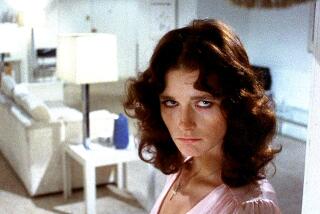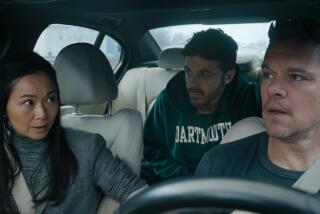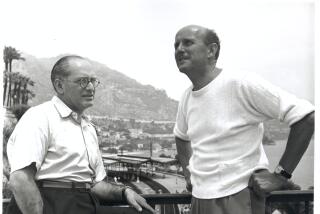The Contenders: Martin Scorsese goes childlike with ‘Hugo’
“The shot’s out of focus!” Martin Scorsese would often say on the set of “Hugo,” as he watched replays of scenes that had just been shot. “Wait a second,” producer Graham King would say. “Your 3-D glasses aren’t on.”
Remembering to flip down his stereoscopic spectacles was only part of the director’s education while filming “Hugo.” The director of “Taxi Driver” and “GoodFellas” had to develop a new cinematic language — one that not only accommodated 3-D cameras but also looked at the world from a child’s perspective, somehow capturing the central, 12-year-old character’s sense of wonder, fear and inquisitiveness.
“I was responding to that wonderful mystery — a young child’s mystery unraveling, unlocking the question, ‘What does existence mean?’” Scorsese said.
MORE: Oscar Nominees | Play-at-home Ballot | Buzzmeter
While the results have not yet been commercially remunerative — “Hugo” has struggled at the box office since its release more than two months ago — the critical and awards voter reaction has been glowing, with “Hugo” collecting a leading 11 Academy Award nominations, including best picture and director. All of a sudden, “Hugo” is in the thick of the Oscar race, up there with front-runners “The Artist” and “The Descendants.”
“It was worth all of the discovery,” Scorsese said of shooting the film, which lasted an epic 140 days (“The Artist” was 35), a consequence of shooting in 3-D and with children, whose acting hours are severely limited by English labor laws. “We just kept our nose above water as best we could.”
Scorsese’s previous films — none of which has been aimed at family audiences — are typically anchored by menace, but those perils are usually physical. “Hugo,” adapted from the popular children’s book “The Invention of Hugo Cabret” by Brian Selznick, explores a very different kind of danger: the panic of being parentless, all alone in the world.
MORE: Play-at-home Ballot | Cheat Sheet | Heatmeter
The star of the film (played by the now 14-year-old Asa Butterfield) sees the world in extremes, some of which are obvious. When he looks at the stacks in Monsieur Labisse’s bookstore, they tower above him like a modern skyscraper, impossibly tall and vaguely terrifying.
“I was trying to capture what you would have remembered years later, what the world looked like,” Scorsese said. “If you ever go back to the apartment you grew up in or the house you grew up in, it’s perceived differently when you’re an adult. There’s this extraordinary, almost elegiac magic in a way to think about: ‘I thought that window frame was so big.’ And now you see, ‘It’s smaller than me.’”
That exaggerated attitude shaped how Scorsese, cinematographer Robert Richardson and production designer Dante Ferretti tried to re-create early 20th century France and the film’s central train station, which they built from the ground up on a London sound stage. Anyone who has visited the City of Light might subconsciously recognize some of “Hugo’s” Parisian landmarks and streets, but they ultimately — and intentionally — feel more fanciful than factual.
“Some of the greatest pictures with children as leads have been photo-real,” Scorsese said. “But the fact that this picture deals with the illusion of motion — why don’t we continue the illusion? I wanted it to be realistic but stylized. Not abstract in any way, but stylized in that it appears to be realistic but it’s heightened, so that it’s almost like it’s the child’s memory, the child’s perception.”
The narrative strength, and one of the cinematic liabilities, of Selznick’s heavily illustrated book is that it’s largely a reflection of the boy’s interior dialogue. “It’s a different form,” the director said. “The book is a book. A script is a script. A film is a film. They’re three different forms, really. And what’s in the book is implied in the movie.”
But even as screenwriter John Logan was obligated to turn thought into action, he and Scorsese tried to interpose many of Selznick’s pictures into the finished film, from the film’s opening shot of the busy train platform to a sequence in which he is nearly run over by a locomotive — some of “Hugo’s” frames are almost exact replications from the novel.
At the same time, Scorsese and Richardson wanted to use 3-D cameras, the director’s first use of the technology, to plunge audiences into the midst of the action, so they might also experience the bustling train station just as it comes at Hugo, with both its peril and promise of a better life.
“We wanted to take the audience and immerse them in that, not have them look at it from the outside — to make them feel they’re part of that world and that a lot of people in the world are actually very nice.”
MORE: Oscar Nominees | Play-at-home Ballot | Cheat Sheet | Buzzmeter | Heatmeter
More to Read
The biggest entertainment stories
Get our big stories about Hollywood, film, television, music, arts, culture and more right in your inbox as soon as they publish.
You may occasionally receive promotional content from the Los Angeles Times.











